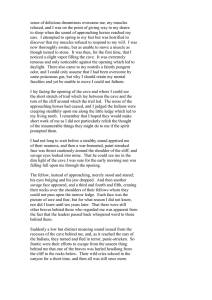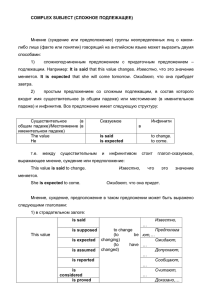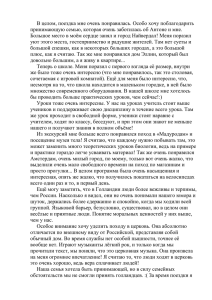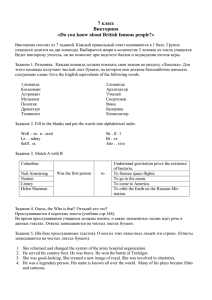Об адекватности грамматических упражнений при подготовке к
реклама
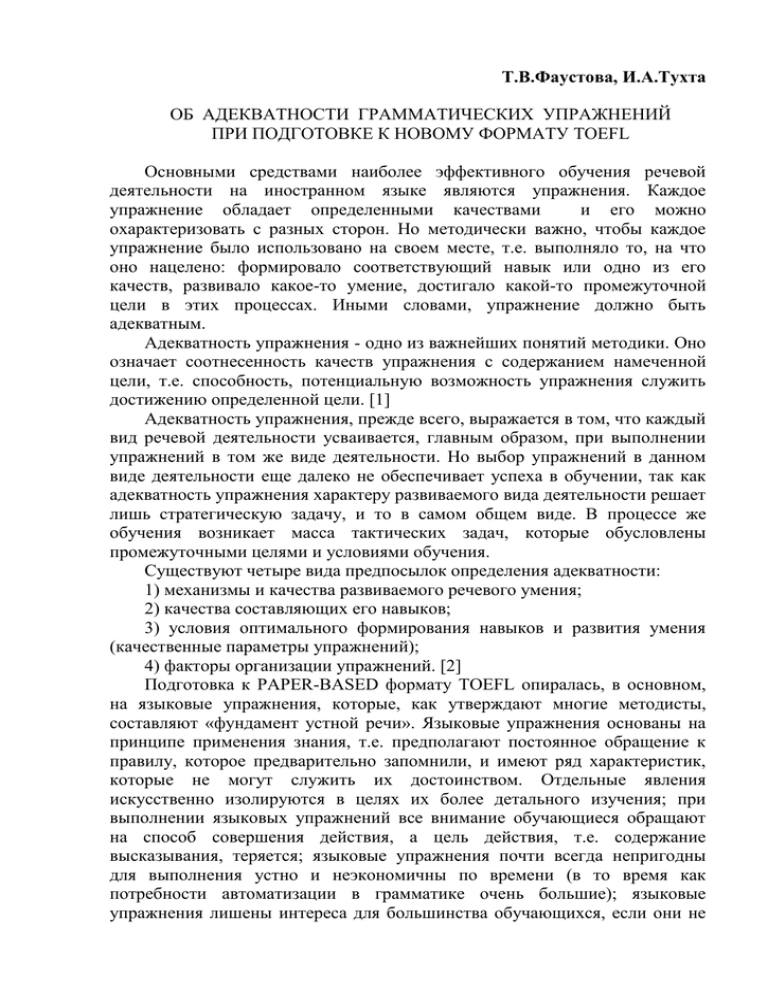
Т.В.Фаустова, И.А.Тухта ОБ АДЕКВАТНОСТИ ГРАММАТИЧЕСКИХ УПРАЖНЕНИЙ ПРИ ПОДГОТОВКЕ К НОВОМУ ФОРМАТУ TOEFL Основными средствами наиболее эффективного обучения речевой деятельности на иностранном языке являются упражнения. Каждое упражнение обладает определенными качествами и его можно охарактеризовать с разных сторон. Но методически важно, чтобы каждое упражнение было использовано на своем месте, т.е. выполняло то, на что оно нацелено: формировало соответствующий навык или одно из его качеств, развивало какое-то умение, достигало какой-то промежуточной цели в этих процессах. Иными словами, упражнение должно быть адекватным. Адекватность упражнения - одно из важнейших понятий методики. Оно означает соотнесенность качеств упражнения с содержанием намеченной цели, т.е. способность, потенциальную возможность упражнения служить достижению определенной цели. [1] Адекватность упражнения, прежде всего, выражается в том, что каждый вид речевой деятельности усваивается, главным образом, при выполнении упражнений в том же виде деятельности. Но выбор упражнений в данном виде деятельности еще далеко не обеспечивает успеха в обучении, так как адекватность упражнения характеру развиваемого вида деятельности решает лишь стратегическую задачу, и то в самом общем виде. В процессе же обучения возникает масса тактических задач, которые обусловлены промежуточными целями и условиями обучения. Существуют четыре вида предпосылок определения адекватности: 1) механизмы и качества развиваемого речевого умения; 2) качества составляющих его навыков; 3) условия оптимального формирования навыков и развития умения (качественные параметры упражнений); 4) факторы организации упражнений. [2] Подготовка к PAPER-BASED формату TOEFL опиралась, в основном, на языковые упражнения, которые, как утверждают многие методисты, составляют «фундамент устной речи». Языковые упражнения основаны на принципе применения знания, т.е. предполагают постоянное обращение к правилу, которое предварительно запомнили, и имеют ряд характеристик, которые не могут служить их достоинством. Отдельные явления искусственно изолируются в целях их более детального изучения; при выполнении языковых упражнений все внимание обучающиеся обращают на способ совершения действия, а цель действия, т.е. содержание высказывания, теряется; языковые упражнения почти всегда непригодны для выполнения устно и неэкономичны по времени (в то время как потребности автоматизации в грамматике очень большие); языковые упражнения лишены интереса для большинства обучающихся, если они не находят выхода в речь; языковые упражнения абсолютно лишены ситуативной отнесенности: перед говорящим стоит не речевая, а языковая, формальная задача. Однако полностью отказываться от языковых упражнений не целесообразно: они способны помочь осознанию изучаемой формы, их следует использовать в качестве части домашнего задания и при обучении письму. Подготовка к новому формату TOEFL требует пересмотра в подходе к обучению грамматике с упором на речевые упражнения, основными параметрами которых являются мотивированность, контекстуальная обусловленность, связность материала и направленность внимания говорящего на содержание и цель высказывания. Новые цели формируют и новую задачу: создание комплекса репродуктивных и продуктивных упражнений, способствующих переносу сформированных языковых навыков в речь. Представляется возможным предложить следующие виды упражнений. 1. Упражнения на коррекцию ошибок. [3] Учитывая, что необходимо отказаться от множественного выбора (multiple choice), упражнения могут иметь следующий вид: а) Read the text below and look carefully at each line. If the line is correct, put “+”. If it has a word that should not be there, write this word on the line, as in the examples. Up Up and Away! On October 6th, I am going to the International Balloon Fiesta which will get on underway in Albuquerque, New Mexico. It is a colourful festival which it started in 1972 with just 15 balloons. Now, it has been grown into one which attracts more than 1,000 balloons from countries as far away from as Brazil, South Africa, Turkey and more. 0 00 1 2 3 4 5 + on б) Find and correct mistakes in the following sentences: 1) Last Saturday I attended the party giving by one of my friends. My friend, who his apartment is in another town, was very glad that I could come. 2) There is an old legend telling among people in my country about a man lived in the seventeenth century saved a village from destruction. 3) People can speak English can be understood in many countries. 2. Упражнения на изменение структуры предложения. а) Complete the second sentence using the word in bold. You must use between two and five words, including the word given. 1) He will never use that travel agent again. last It’s the………. that travel agent. 2) If you don’t leave immediately, you’ll miss your flight. unless You’ll miss your flight………. right away. 3) You needn’t wait for me. I’ll be a long time. point There’s………. for me. I’ll be a long time [4]. б) Combine the following sentences into one. 1. Moby Dick was written by Herman Melville. 2. Moby Dick is a famous novel. 3. Moby Dick is about a whale. 4. The whale is white. Нужно выбрать предложение, отражающее основную мысль и добавлять в него остальные в виде придаточных предложений, инфинитивных или герундиальных конструкций и т.п. Результат может быть следующим: Moby Dick by Herman Melville is a famous novel about a white whale. Or: Moby Dick, a famous novel by Herman Melville, is about a white whale. Or: Herman Melville’s Moby Dick is a famous novel about a white whale [5]. 3. Упражнения на нахождение логической связи между отдельными частями текста. а) Read the news report below and put the paragraphs in the correct order. A. Tony Morris, 34, was driving a blue Ford Escort when he turned the corner and crashed into a minibus traveling in the opposite direction. A passer-by who witnessed the accident said that the minibus had been moving at almost twice the legal speed limit. B. A policeman at the scene commented that the street lighting in the area was not up to standard and that the council should expect more accident in future if they did not make improvements. C. A man was seriously injured in a collision at the corner of Main Street and Green Road in Riverton late yesterday evening. D. Mr. Morris was on his way to meet friends in a restaurant when the accident happened. He is said to be making a quick recovery at Riverton County Hospital. The driver of the minibus escaped unharmed, but has been charged with dangerous driving [6]. б) Read the passage, take notes on the main points of the reading passage. Garlic, a member of the lily family with its distinctive odor and taste, has been used throughout recorded history because it was considered to have beneficial properties. The earliest known record of its use is in Sanskrit records from 3,000 B.C. It was used as a medicine in Ancient Egypt, where it was used to cure 22 different ailments. It was also fed to the slaves who were building the pyramids because the Egyptians believed that, in addition to keeping the slaves healthy so that they could continue to work, garlic would make the slaves stronger so that they could work harder. The ancient Greeks and Romans found even more uses for garlic than the Egyptians had. In addition to using garlic to cure illnesses, as the Egyptians had, the Greeks and Romans believe that garlic had magical powers, that it could ward off evil spells and curses. Garlic was also fed to soldiers because it was believed to make men more courageous. Quite a few seafaring cultures have also used garlic because they believed that it was beneficial in helping sailors to endure long voyages. Homer used it on his odysseys, the Vikings always carried garlic on their long voyages in the northern seas, and Marco Polo left records showing that garlic was carried on his voyages to the Orient. Finally, even as late as early in the twentieth century, it was believed that garlic could fight infections. Because of this belief, garlic juice was applied to soldiers’ wounds in World War I to keep infection at bay and to prevent gangrene. Then, listen to the passage taking notes on the main points and answer the following question: How does the information in the listening passage support the information presented in the reading passage [7]? в) Read (Listen to) the following passage and continue it. James was walking along the paths looking at the animals. The zoo was rather empty at that time of the day. It was two o’clock and it was cold and wet – not the best day for a visit to the zoo. James stopped at front of the gorilla’s cage. The animal raised its head and looked at him. James was shocked. There were cuts on its face and its fur was dirty. The gorilla reached out of the cage and touched his hand as if it was asking for help [3]. Представленные выше типы упражнений для нового формата TOEFL обладают мотивированностью, контекстуальной обусловленностью, связностью материала и направленностью внимания говорящего на содержание и цель высказывания. Список использованной литературы 1. Пассов Е.И. Основы Методики обучения иностранным языкам. - М.: Русский язык, 1977. 2. Костомаров В.Г. Требования к грамматическим упражнениям. /Материалы Пятого международного методического семинара преподавателей русского языка стран социализма. - М., 1965. 3. Myrna Knepler (Northeastern Illinois University), A Grammar with a Purpose, A contextualized Approach, Heinle and Heinle Publishers, Boston, Massachusettes 02116, U.S.A., 1990. 4. Constance Immel, Florance Sacks (West Los Angeles College) Sentence Dynamics, An English Skills Worbook, Second Edition, Scott, Foresman and Company, Glenview, Illinois, London, England, 1987. 5. William Salomone, Stephen McDonald, Mark Edelstein, William Goede Inside Writing A Writer`s Worbook, First Canadian Edition, Nelson, a division of Thomson Learning, 2000. 6. Marcia Heiman, Joshua Slomianko, Success in College and Beyond, learning to Learn, Inc., 1992. 7. Deborah Phillips, Longman Preparation Course for the TOEFL Test, by Pearson Education, Inc, 2006.
